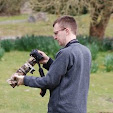A late 'winter' cold put paid to any thoughts I may have harboured about wandering further afield this weekend, so I indulged myself on Saturday with Lemsip and a lie-in. Suitably refreshed and a little stir crazy by Sunday, I managed a gentle stroll around Ballard Down to get my quota of fresh air, flora and fauna. Encouraged by the results I have been getting recently with my '1st summer' 100-400mm lens, I also aimed to get some more butterfly photographs. And very rewarding it was too, despite the imperfect weather, with some interesting colour variants of female Adonis Blue among the highlights.
 |
| Female Adonis Blue - one of the bluest I have seen, a mesmerising aberration - apparently this is more common in spring broods |
 |
| Another striking individual - even bluer than the one above, but with orange hindwing spots reduced in brightness - nectaring on Horseshoe Vetch, which is also the larval foodplant |
 |
| A more conventional female Adonis |
 |
| The stunning male Adonis Blue |
 |
| A number of males were quite approachable in the cool conditions of Sunday afternoon |
 |
| And finally, a pair of Adonis Blues doing their bit for the next generation |
 |
| A male Common Blue - more lilac in colouration than the Adonis, and note how the white outer fringes to the wings are unbroken by black marks |
 |
| A Common Blue roosting up in overcast conditions |
 |
| This is a female Common Blue - like the female Adonis above, this one is at the bluer end of the spectrum |
 |
| Don't be fooled by the name 'Brown Argus' - this was the third species of blue I saw on the wing at Ballard Down |
 |
| Brown Argus underside - they were relatively inactive in the overcast conditions |
 |
| Fortunately, this provided the opportunity for close study of roosting individuals - I love the rich orange spotting on the underside |














Amazing pictures. It seems that your lens is worth its salt.
ReplyDeleteI hope to be in the UK this summer and that I will be able to see nature as you do.
Keep up the good work! Its a blessing when living in a world peopled by sparrows.
Thanks Bill, yes the lens is proving lots of fun!
ReplyDelete